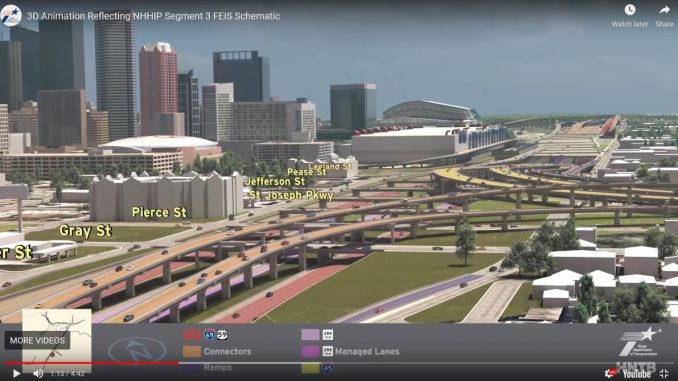
Hi Everyone!
It’s been a while since I’ve posted, but unfortunately I got a “motivational” email over the Thanksgiving weekend from the Houston Chronicle that the I-45 expansion project has raised the specter of racial equity. To wit: The expansion of I-45 from downtown Houston through to roughly Beltway 8, officially known as the North Houston Highway Improvement Project, has been hit with the worst charge anybody can now hurl at anybody in modern day American politics. Namely, the project is raycist racist because the project is predominantly going to involve taking homes and businesses in areas that are largely Latino or Black in population. This mirrors the America’s highways are racist rhetoric that came from U.S. transportation secretary Pete Buttigieg recently. The secretary made those remarks after not having shown up for work for two months because he had brought two new kids into his family.
What ticks me off about this is not the rhetoric. Nobody in his or her right mind is going to deny America’s long history of mistreating Blacks or other minorities. Yet, history is hard and there’s some nuance that is missing out of the rhetoric that America’s highways are racist. One big piece of nuance that is missing is that infrastructure projects have been used by the Powers-That-Are in every society since the time of ancient Rome to separate or segregate groups of people. Not that this is right, but for better or for worse, they have been. Also, if you read the legislative history of how the Interstate Highway System came into being, there were several failed attempts to push through a federal system of highways before the final act was passed in 1956. One big, fairly late change in the process was this:
At first glance, prospects for bipartisan agreement on the highway program seemed slim in 1956, a presidential election year. But changes had been occurring that would turn the situation around in 1956. One of the important changes was BPR’s designation of the remaining 3,500 km of the interstate system, all of it in urban areas, in September 1955. BPR also published General Location of National System of Interstate Highways, which became known as “The Yellow Book” because of the color of its cover.
It contained a map of the interstate system as designated in August 1947 plus maps of 100 urban areas showing where designated interstate roadway would be located. A copy of The Yellow Book was provided to each member of Congress as a way of emphasizing the importance of the interstate system to the nation’s urban areas.
In other words, for much of the system’s early legislative history, the original vision was that the Interstate roads would approach the cities, but then loop roads would be constructed that would circle around urban areas, leaving the cities and urban areas relatively unscathed. That changed when the Bureau of Public Roads (as it was known at the time) threw in a few thousand miles of Interstate roads that would go through the cities. My thought is that it was highly likely that big city mayors and downtown interest groups threw a fit and lobbied like crazy to make sure the Interstates ran through the cities, devil be damned about what happened to anyone unfortunate enough to be in the way. And which political party was in charge of America’s cities at the time? You guessed it – like today, the Democrats were largely in political control of the cities. Hence, when it comes to this America’s highways are racist rhetoric, I can’t help but think that the Ds are trying to cover up their past in their role of the paving over and breaking up minority neighborhoods two-to-three generations ago.
Another rebuttal I have of this America’s highways are racist rhetoric is more local in nature. Two big road infrastructure projects that have been completed in Houston over the past 10-20 years are the expansion of Interstate 10 / Katy Freeway, and the expansion of U.S. 290. Both freeway expansions took property away, but nobody, anywhere, ever once heard Rodney Ellis, Adrian Garcia, Sylvester Turner, or any other prominent D politician, or for that matter the Houston Chronicle editorial board, say boo about racism when those projects were being built. Why? Well, maybe it was because the I-10 and U.S. 290 expansions went through primarily white areas of Houston, which you see is perfectly fine and that doesn’t count as being racist. Neither does the never-say-die Houston-Dallas high speed rail line count as being racist, because the HSR line would go through 250 miles of rural Texas, and most rural dwellers are white folks.
Now, none of this is to say that property owners should not be fully compensated when the I-45 expansion gets going. And, I have changed my mind over supporting the project from last year, as I’ve recently taken a new job where I’m back in downtown Houston and I’ve seen the traffic congestion build back up to near where it was before COVID struck. All the same, if the Ds (abetted by the Houston Chronicle) are going to wail about how highways are racist and that they shouldn’t get built, they are using rhetoric that is not only stuck in the past (at least for Houston) because modern day Houston freeway expansions now constitute equal opportunity racism, but they are also overlooking that where freeways get built is way down on the list of things that really hurt America’s modern-day minorities. Try improving school and educational outcomes for minorities, or for that matter try reining in monetary inflation, which will hurt poorer Americans more than anyone else. Expanding I-45 might take a few hundred properties of mostly Blacks and Hispanics, but poor educational outcomes and inflation hurt many more Blacks and Hispanics no matter where they are.
And that’s why I became bent out of shape reading that the I-45 expansion project is raycist racist.


